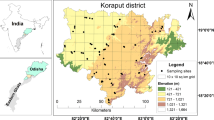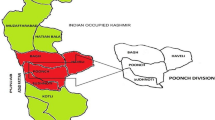Abstract
The aim of this study is to provide a qualitative and quantitative analysis of the earthworm community in habitats that are differentiated by the gradient of agricultural land use intensity, as well as differentiated natural ecosystems. The material was collected from the central part of Serbia. In addition to population density, as one of the basic structural characteristics, we used relative numerous relationships of individual populations to analyze the structure of the earthworm community. A total of 16 earthworm species were identified. The highest species richness was registered in primary ecosystems, with the highest number of registered species amounting to 12. The highest number of species belonged to the genera Allolobophora and Aporrectodea. However, Aporrectodea rosea (Savigny, 1826) was identified as an edificatory. These are the species that have the highest tolerance threshold on adverse climatic and ecological conditions, and have exceptional survival ability. The lumbricid fauna of mesophilic meadows, with several cosmopolitan species, was fairly uniform. In conventional fields, as well as in organic ones, earthworm populations were poor, and non-associative. Our analysis of the earthworm community in different ecosystems provides an insight into the current state of the examined ecosystems and represents a good basis for applied research in soil ecology.


Similar content being viewed by others
References
European Environment Agency (2011) Biogeographic regions dataset. Permalink. http://www.eea.europa.eu/data-andmaps/data/ds_resolveuid/b2515476c53448d39b499915cd34dde7. Accessed 3 March 2019
Bartz MLC, Brown GG, da Rosa MG, Filho OK, James SW, Decaëns T, Baratta D (2014) Earthworm richness in land-use systems in Santa Catarina, Brazil. Appl Soil Ecol 83:59–70. https://doi.org/10.1016/j.apsoil.2014.03.003
Berry EC, Karlen DL (1993) Comparisons of alternative farming systems. II. Earthworm population density and species diversity. Am J Alternative Agr 8:21–26
Bhadauria T, Kumar P, Kumar R, Maikhuri RK, Rao KS, Saxena KG (2012) Earthworm populations in a traditional village landscape in central Himalaya, India. Appl Soil Ecol 53:83–93. https://doi.org/10.1016/j.apsoil.2011.11.011
Blakemore R (2004) A provisional list of valid names of Lumbricoidea (Oligochaeta) after Easton, 1983. Universidad Complutense, Madrid, pp 75–120
Brooks D, Bater J, Jones H, Shah PA (1995) Invertebrate and weed seed food-sources for birds in organic and conventional farming systems. BTO Report No. 154, BTO, Thetford
Chan KY (2001) An overview of some tillage impacts on earthworm population abundance and diversity: implications for functioning in soils. Soil till Res 57:179–191. https://doi.org/10.1016/S0167-1987(00)00173-2
Chaudhuri P, Singh SM (2014) Biology and ecology of tropical earthworms. DPH Pvt Ltd, New Delhi
Chaudhuri PS, Nath S (2011) Community structure of earthworms under rubber plantations and mixed forests in Tripura India. J Environ Biol 32:537–541
Csuzdi C, Zicsi A (2003) Earthworms of Hungary (Annelida: Oligochaeta: Lumbricidae). In: Csuzdi C, Mahunka S (ed) Pedozoologica Hungarica. Vol. 1, Hungarian Natural History Museum, Budapest, pp 1–271
Culy MD, Berry EC (1995) Toxicity of soil-applied granular insecticides to earthworm populations in cornfields. Down Earth 50:20–25
De Oliveira T, Bertrand M, Roger-Estrade J (2012) Short-term effects of ploughing on the abundance and dynamics of two endogeic earthworm species in organic cropping systems in northern France. Soil Tillage Res 119:76–84. https://doi.org/10.1016/j.still.2011.12.008
Dufrêne M, Legendre P (1997) Species assemblages and indicator species: the need for a flexible asymmetrical approach. Ecol Monogr 67:345–366
Edwards CA, Bohlen PJ (1996) The influence of environmental factors on earthworms. In: Edwards CA, Bohlen PJ (eds) Biology and ecology of earthworms. Chapman & Hall, London, pp 134–162
Edwards CA (1983) Earthworm ecology in cultivated soils. In: Satchel JE (ed) Earthworm ecology - from Darwin to vermiculture. Chapman & Hall, London, pp 123–137
Ernst G, Emmerling C (2009) Impact of five different tillage systems on soil organiccarbon content and the density, biomass, and community composition of earthworms after a ten year period. Eur J Soil Biol 45:247–251
Gardi C, Montanarella L, Arrouays D, Bispo A, Lemanceau P, Jolivet C, Mulder C, Ranjard L, Römbke J, Rutgers M, Menta C (2009) Soil biodiversity monitoring in Europe: ongoing activities and challenges. Eur J Soil Sci 60:807–819. https://doi.org/10.1111/j.1365-2389.2009.01177.x
Gerhardt RA (1997) A comparative analysis of the effects of organicn and conventional farming systems on soil structure. Biol Agric Hortic 14:139–157. https://doi.org/10.1080/01448765.1997.9754803
González G, García E, Cruz V, Borges S, Zalamea M, Rivera M (2007) Earthworm communities along an elevation gradient in Northeastern Puerto Rico. Eur J Soil Biol 43(Suppl 1):S24–S32. https://doi.org/10.1016/j.ejsobi.2007.08.044
Hackenberger KD, Hackenberger KB (2014) Earthworm community structure in grassland habitats differentiated by climate type during two consecutive seasons. Eur J Soil Biol 61:27–34. https://doi.org/10.1016/j.ejsobi.2014.01.001
Hole DG, Perkins AJ, Wilson JD, Alexander IH, Grice PV, Evans AD (2005) Does organic farming benefit biodiversity? Biol Conserv 122:113–130
ISO 2361 (2005) Soil quality — Sampling of soil invertebrates — Part 1: Hand-sorting and formalin extraction of earthworms
Jamatia SKS, Chaudhuri PS (2017) Earthworm community structure under tea plantations (Camellia sinensis) of Tripura (India). Trop Ecol 58(1):105–113
Kalu S, Koirala M, Khadaka UR (2015) Earthworm population in relation to different land use and soil characteristics. J Ecol Nat Environ 7(5):124–131. https://doi.org/10.5897/JENE2015.0511
Klemens E, Stierhof T, Dauber J, Kreimes K, Wolters V (2003) On the quality of soil biodiversity indicators: abiotic and biotic parameters as predictors of soil faunal richness at different spatial scales. Agr Ecosyst Environ 98:273–283. https://doi.org/10.1016/S0167-8809(03)00087-2
Lee KE (1985) Earthworms: Their ecology and relationships with soils and land use. Academic Press, New York
Liebig MA, Doran JW (1999) Impact of organic production practices on soil quality indicators. J Environ Qual 28:1601–1609. https://doi.org/10.2134/jeq1999.00472425002800050026x
Lofs-Holmin A (1983) Earthworm population dynamics in different agricultural rotations. In: Satchell JE (ed) Earthworm ecology - from Darwin to vermiculture. Chapman & Hall Press, London, pp 151–160
Mršić N (1991) Monograph on earthworms (Lumbricidae) of the Balkans I-II. Slovenska Akademija Znanosti in Umetnosti. Ljubljana
Nuutinen V, Haukka J (1990) Conventional and organic cropping systems at Suitia. VII: Earthworms. J Agric Sci 62:357–367
Parthasarathi K, Jayanthi L, Ameer Basha S (2013) Population dynamics of earthworms in cauvery delta areas in relation to soil properties. Indian Stream Res J 3(10):1–8
Parthasarathi K, Balamurugan M, Prashija KV, Ameer Basha S (2015) Earthworms population and community structure from agroecosystems of Cauvery delta areas of Tamilnadu state, India. Blaze J Biodivers Conserv 1(1):1–13
Pelosi C, Bertrand M, Roger-Estrade J (2009) Earthworm community in conventional, organic and direct seeding with living mulch cropping systems. Agron Sustain Dev 29:287–295. https://doi.org/10.1051/agro/2008069
Pelosi C, Toutous L, Chiron F, Dubs F, Hedde M, Muratet A, Ponge JF, Salmon S, Makowski D (2013) Reduction of pesticide use can increase earthworm populations inwheat crops in a European temperate region. Agr Ecosyst Environ 181:223–230. https://doi.org/10.1016/j.agee.2013.10.003
Pfiffner L, Mäder P (1997) Effects of biodynamic, organic and conventional production systems on earthworm populations. Biol Agric Hortic 15:2–10. https://doi.org/10.1080/01448765.1997.9755177
Pielou EC (1966) The measurement of diversity in different types of biological collections. J Theor Biol 13:131–144
Pop VV (1997) Earthworm-vegetation-soil relationships in the Romanian Carpathians. Soil Biol Biochem 29:223–229
Römbke J, Jänsch S, Didden W (2005) The use of earthworms in ecological soil classification and assessment concepts. Ecotox Environ Safe 62:249–265. https://doi.org/10.1016/j.ecoenv.2005.03.027
Rüdisser J, Tasser E, Peham T, Meyer E, Tappeiner U (2015) The dark side of biodiversity: Spatial application of the biological soil quality indicator (BSQ). Ecol Indic 53:240–246. https://doi.org/10.1016/j.ecolind.2015.02.006
Šapkarev J (1978) Kišne gliste Jugoslavije. Sadašnja taksonomska proučenost i njihova dalja istraživanja. Biosistematika 4:293–304
Sims RW, Gerard BM (1999) Earthworms. FSC Publications, London
Smith RG, McSwiney CP, Stuart Grandy A, Suwanwaree P, Snider RM, Robertson GP (2008) Diversity and abundance of earthworms across an agricultural land-use intensity gradient. Soil Tillage Res 100:83–88. https://doi.org/10.1016/j.still.2008.04.009
Stojanović M, Sekulić J, Trakić T (2018) Checklist of earthworms (Oligochaeta: Lumbricidae) from Serbia: a review. Zootaxa 4496(1):124–155. https://doi.org/10.11646/zootaxa.4496.1.9
Stojanović M (1996) Faunističko-ekološka studija Lumbricida (Oligochaeta) Srbije. Dissertation, University of Kragujevac
Stojanović-Petrović M, Trakić T, Sekulić J. (2020) Kišne gliste (Oligochaeta: Lumbricidae) Srbije. Univerzitet u Novom Sadu
Tarrant KA, Field SA, Langton SD, Hart ADM (1997) Effects on earthworm populations of reducing pesticide use in arable crop rotations. Soil Biol Biochem 29:657–661
Tischler W (1949) Grundzüge der terrestrischen Tierökologie. Friedrich Vieweg, Braunschweig
Tu C, Wang Y, Duan W, Hertl P, Tradway L, Brandenburg R, Lee D, Snell M, Hu S (2011) Effects of fungicides and insecticides on feeding behavior and community dynamics of earthworms: Implications for casting control in turfgrass systems. Appl Soil Ecol 47:31–36. https://doi.org/10.1016/j.apsoil.2010.11.002
Urban NA, Swihart RK, Malloy MC, Dunning JB (2012) Improving selection of indicator species when detection is imperfect. Ecol Indic 15:188–197. https://doi.org/10.1016/j.ecolind.2011.09.031
Van Gestel CAM (1992) Validation of earthworm toxicity tests by comparisonwith field studies: a review of benomyl, carbendazim, carbofuran, and carbaryl. Ecotox Environ Safe 23:221–236. https://doi.org/10.1016/0147-6513(92)90060-g
Weaver W, Shannon CE (1963) The mathematical theory of communication. University of Illinois Press
Whalen JK (2004) Spatial and temporal distribution of earthworm patches in corn field, hayfield and forest systems of southwestern Quebec, Canada. Appl Soil Ecol 27:143–151. https://doi.org/10.1016/j.apsoil.2004.04.004
Yasmin S, D’Souza D (2010) Effects of pesticides on the growth and reproduction of earthworm: a review. Appl Environ Soil Sci 2010:1–9. https://doi.org/10.1155/2010/678360
Zajonc I (1981) Dažďovky (Oligochaeta: Lumbricidae) Slovenska. Biologické práce 27(1), Veda, Slov Akad Vied, Bratislava, pp 134
Zicsi A (1982) Rewision zweier Bretscherischen Regenwurm-Arten (Oligochaeta: Lumbricidae). Rev Suisse Zool 89:553–565
Acknowledgements
This work was supported by the Serbian Ministry of Education, Science and Technological Development (Agreement No. 451-03-68/2022-14/200378 and 451-03-9/2021-14/200122).
Author information
Authors and Affiliations
Corresponding author
Ethics declarations
Conflict of interest
Authors state no conflict of interest.
Additional information
Publisher’s Note
Springer Nature remains neutral with regard to jurisdictional claims in published maps and institutional affiliations.
Supplementary Information
Below is the link to the electronic supplementary material.
Rights and permissions
About this article
Cite this article
Sekulić, J.M., Milenković, S.N., Stojanović, M.M. et al. Species richness and community structure of earthworms (Oligochaeta: Lumbricidae) in natural and agricultural ecosystems. Biologia 77, 2115–2124 (2022). https://doi.org/10.1007/s11756-022-01077-9
Received:
Accepted:
Published:
Issue Date:
DOI: https://doi.org/10.1007/s11756-022-01077-9




